Those who seek high-quality finishing material, may be interested in acrylic paint for walls and ceilings. Manufacturers offer a large assortment, which allows you to choose the best option for a particular room and building facade. We offer you to get acquainted with the main varieties.
Read in the article
- 1 What acrylic wall and ceiling paint consists of: main ingredients
- 2 Technical characteristics of interior acrylic paints
- 3 Types of acrylic paints for walls and ceilings
- 3.1 Matte and glossy acrylic paint
- 3.2 Pearlescent and textured acrylic paint
- 3.3 Water-based acrylic paint for walls and ceilings
- 4 Advantages and disadvantages of acrylic paints for walls and ceilings
- 5 The choice of acrylic paints for walls and ceilings by properties
- 5.1 Washable acrylic paint for walls and ceilings: highlights
- 5.2 Other varieties
- 6 How to decide on the color of interior acrylic paint: useful tips
- 6.1 Variations of white acrylic paint
- 6.2 Colored acrylic paints
- 7 Painting walls and ceilings with acrylic paint
- 7.1 How to prepare the base for painting: sequence of actions
- 7.2 How to paint walls and ceilings with acrylic paint: basic steps
- 8 How to dilute acrylic paint for walls and ceilings: possible options
- 9 Painting walls with acrylic paints with photos in the interior
- 10 Leading manufacturers of acrylic paints for interior use
- 11 How much do acrylic paints for walls and ceilings cost - price overview
What acrylic wall and ceiling paint consists of: main ingredients
High performance characteristics of the formed coating largely depend on the composition of acrylic paints. For the manufacture of such compositions used:
- acrylic resin;
- pigments that affect the appearance of the formed layer and its performance;
- water.
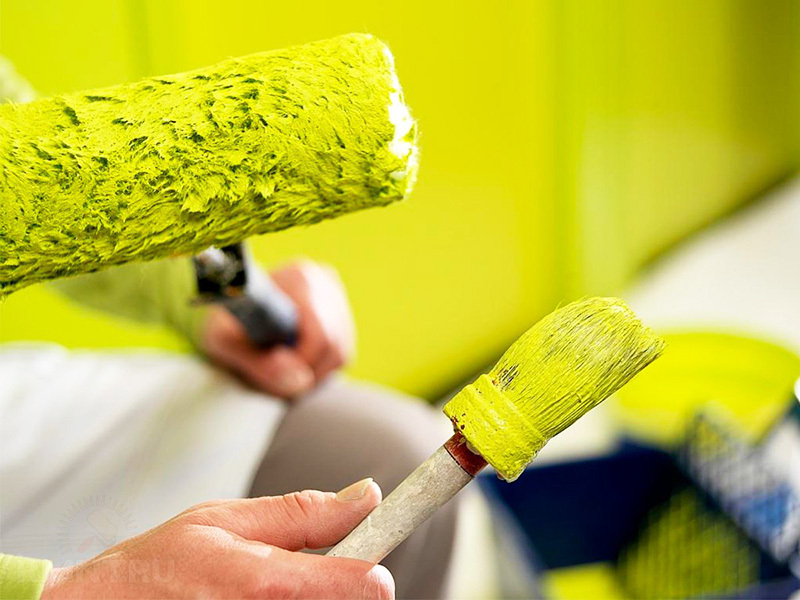
The ratio of components in each specific case is selected by the manufacturer individually.

Technical characteristics of interior acrylic paints
Acrylic paint:
- has a low weight. This allows you to apply the composition even on a fragile base;
- has good hiding power. Due to this, the composition is evenly distributed over the surface, completely overlapping the color of the base;
- can be applied at temperatures above + 15 ° С and humidity level 65–70%;
- allows application to the base of various types;
- dries quickly. Enough 1.5 - 2 hours;
- environmentally friendly;
- durable. A properly formed coating can last more than 10 years;
- when applying acrylic paint, there are no difficulties.
Types of acrylic paints for walls and ceilings
In the catalogs of manufacturers, you can find the composition of various types. How the formed coating will look depends largely on which acrylic paint is preferred. We offer you to get acquainted with the main varieties.
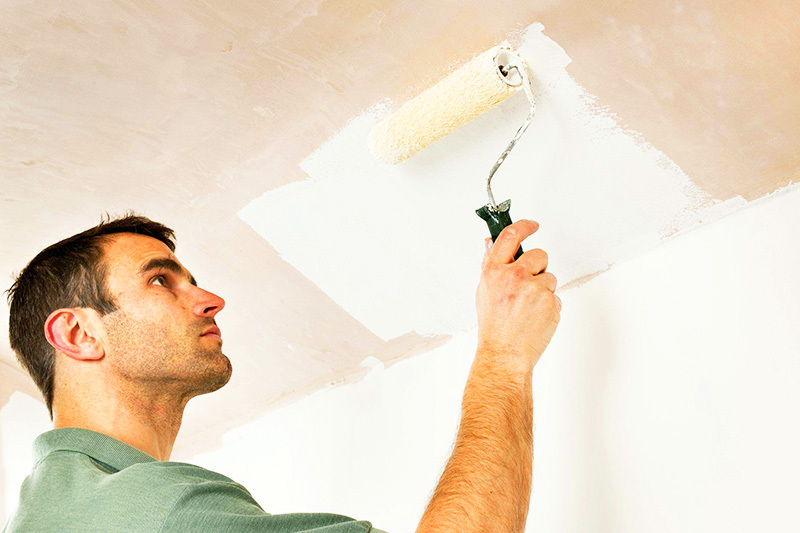
Matte and glossy acrylic paint
Matte acrylic paint is a versatile option. The coating formed with its help is characterized by increased durability, does not fade over time, and retains its original appearance. The composition is often applied to the surface of the ceiling, as it allows you to hide small defects. Therefore, you can abandon the careful preparation of the base.
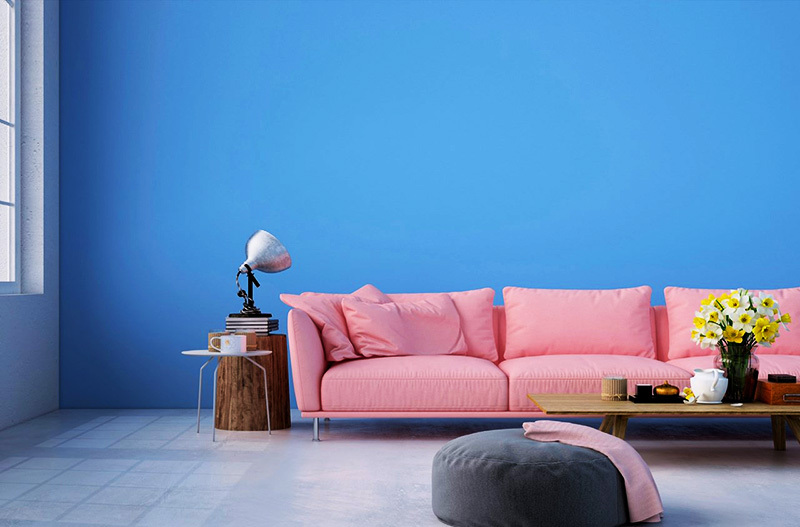
Glossy acrylic paint allows to give a characteristic shine and shade to the surface. However, even minor defects are clearly visible on such a coating, which makes increased demands on the process of preparing the base.

Pearlescent and textured acrylic paint
Pearlescent paint is a unique composition. For its manufacture, only organic components are used. When using it, it is possible to somewhat expand the space of the room, adding some relief to the base. A characteristic pattern forms on the surface.
Textured acrylic paint is also sometimes called textured or structural. The composition is a water-acrylic paint containing a certain amount of a thick structuring filler. Thanks to its presence, it is possible to form a unique relief on the surface of the walls or ceiling.
Textured is used when performing finishing work inside and outside the house. The presence of acrylic binders increases the wear resistance of the coating. It is also not afraid of environmental influences.
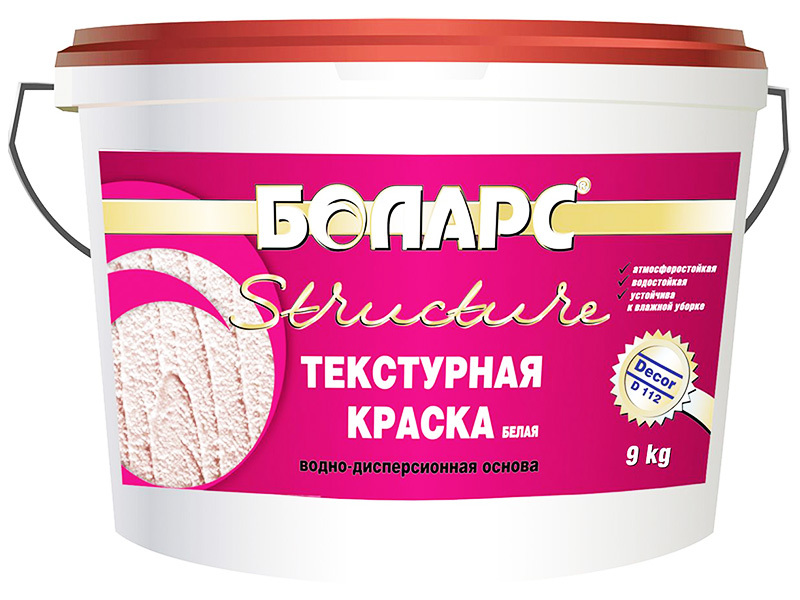
Water-based acrylic paint for walls and ceilings
Water-based acrylic paint for walls is sold ready-made. It can only be used for interior decoration. At the same time, manufacturers offer a wide enough color gamut that allows you to choose the best option for your home. If desired, with the help of a color scheme, you can achieve a more intense shade. Before using water-based acrylic paint for the ceiling, the composition just needs to be mixed. It is usually white in color.
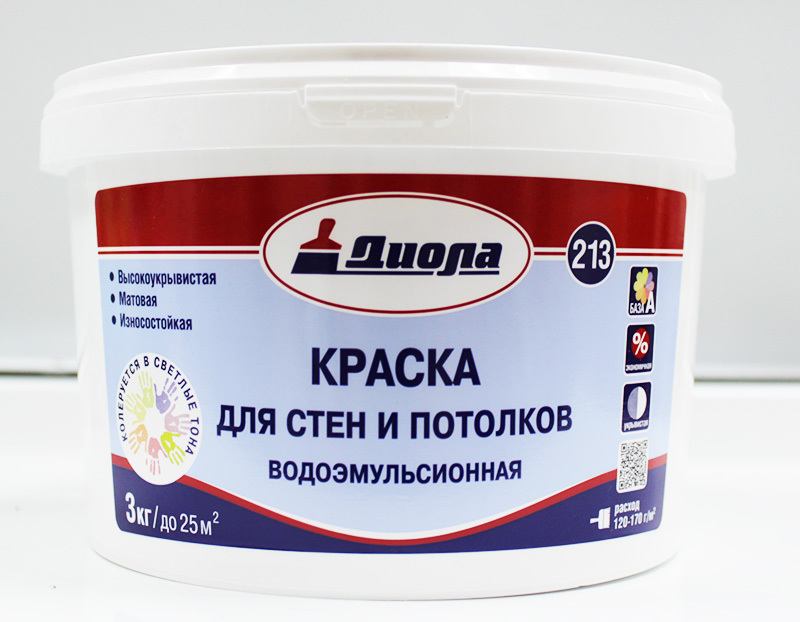
Advantages and disadvantages of acrylic paints for walls and ceilings
Acrylic paint for painting walls and ceilings has a number of undeniable advantages. These include:
- resistance to dirt and easy cleaning. This is facilitated by the high density of the protective layer formed according to all the rules;
- moisture resistance. Low susceptibility to moisture significantly expands the possible area of use of acrylic paint. The coating is not afraid of water and light aggressive solutions;
- resistance to ultraviolet radiation. The walls and ceiling remain the same color for a long time as on the day of application;
- refractoriness. Resistance to high temperatures makes it possible to use it not only in the kitchen, but also in the decoration of industrial premises;
- lack of unpleasant odor. Due to this, water-dispersion paint is used when decorating children's rooms;
- availability. For the manufacture of the composition, components are used that do not have a high cost;
- wide range of colors. You can always choose the right shade for decorating the walls or ceiling in the room;
- fast drying.
Acrylic paint colors come in many shades, so you can create the desired design by choosing the right tone for your room. In addition, the compositions have low vapor permeability, which negatively affects the condition of the base made of porous material.

The choice of acrylic paints for walls and ceilings by properties
Various operating conditions place increased demands on the properties and formulations used for application to walls and ceilings. We invite you to get acquainted with special acrylic paints that can be used for finishing surfaces in need of additional protection.

Washable acrylic paint for walls and ceilings: highlights
If acrylic paint is required for walls and ceilings, which forms a coating that can withstand wet cleaning, you should pay attention to washable compounds. They contain latex, which significantly increases the performance of the protective layer. They are often used to decorate a hallway, kitchen or bathroom. If the dyeing technology has not been violated, the coating will be able to withstand up to 5 thousand wash cycles, retaining its original color. Can be applied to any substrate.
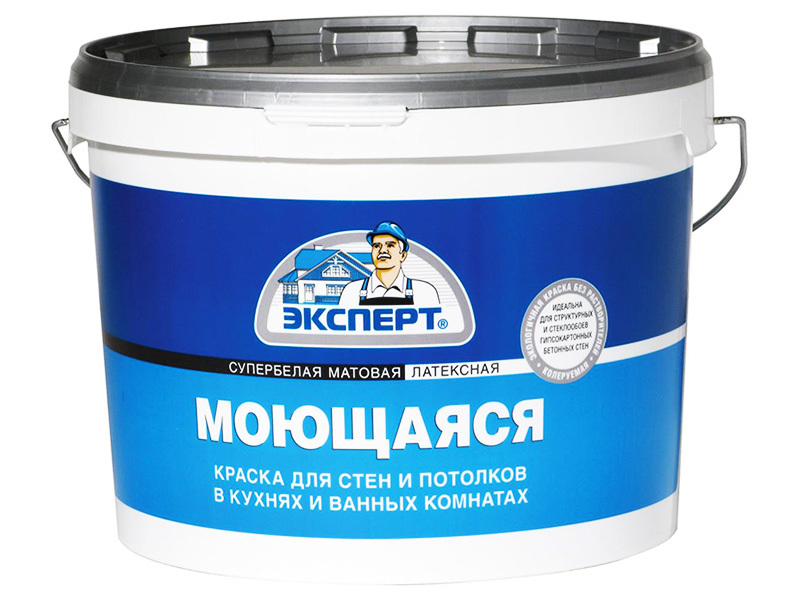
Other varieties
Manufacturers offer formulations for outdoor use. Atmospheric acrylic paint includes special additives: UV protection filters, solvent-borne resin, weather-resistant substances. Thanks to them, the finished coating is not afraid of moisture, does not fade in the sun and does not crack.
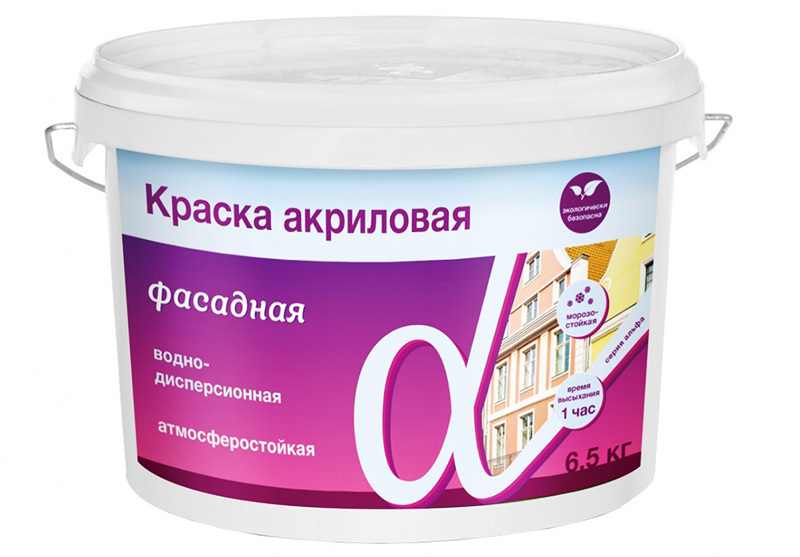
How to decide on the color of interior acrylic paint: useful tips
A wide range of products allows you to choose acrylic paint of a suitable color for painting the ceiling and walls. When choosing a shade, one should take into account the general design of the room for which the composition is being purchased. We offer you to get acquainted with the demanded options and tips for choosing the right composition.
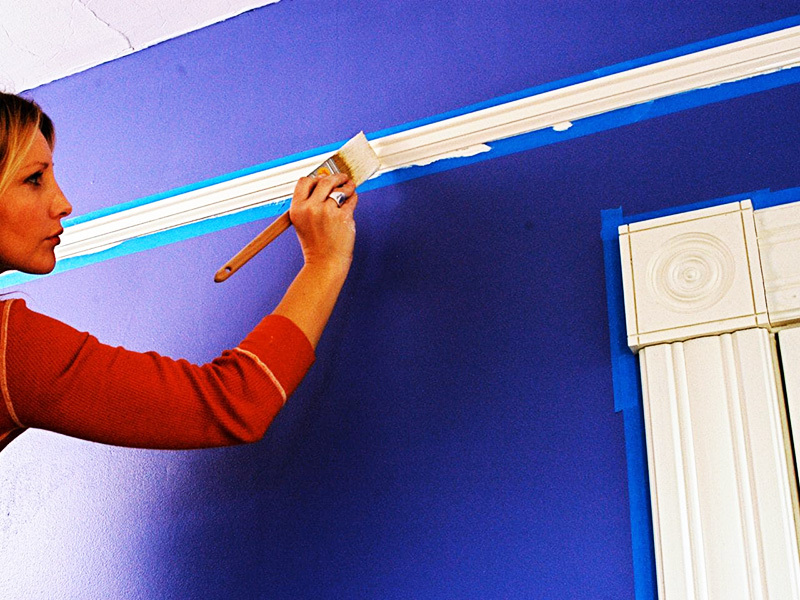
Variations of white acrylic paint
Acrylic whiteness may vary. This allows you to choose the best option for a specific surface. White acrylic paint is:
- super white;
- dairy;
- usual.

A comment
Mikhail Starostin
Head of the team of the repair and construction company "Dom Premium"
"You can use good quality white paper to test the whiteness."
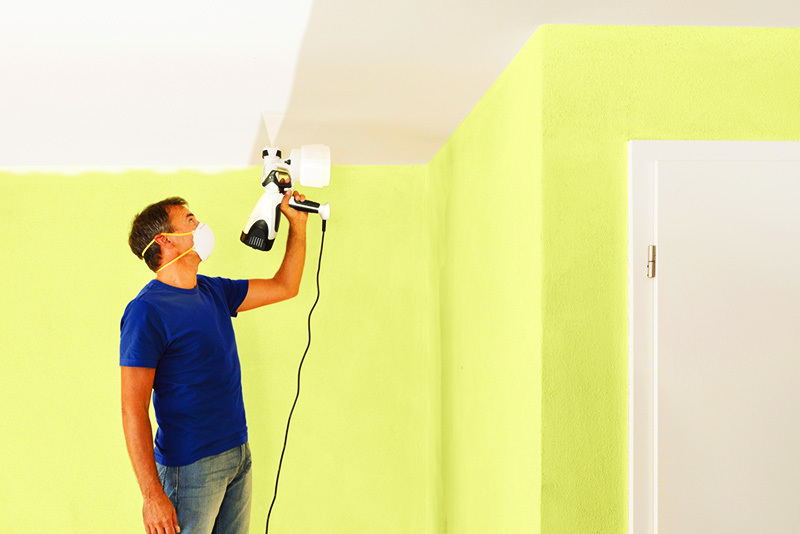
Colored acrylic paints
Most of the marketed formulations are offered in white. You can get the desired shade using a special color scheme. Some manufacturers offer ready-made compositions that allow you to refuse tinting.
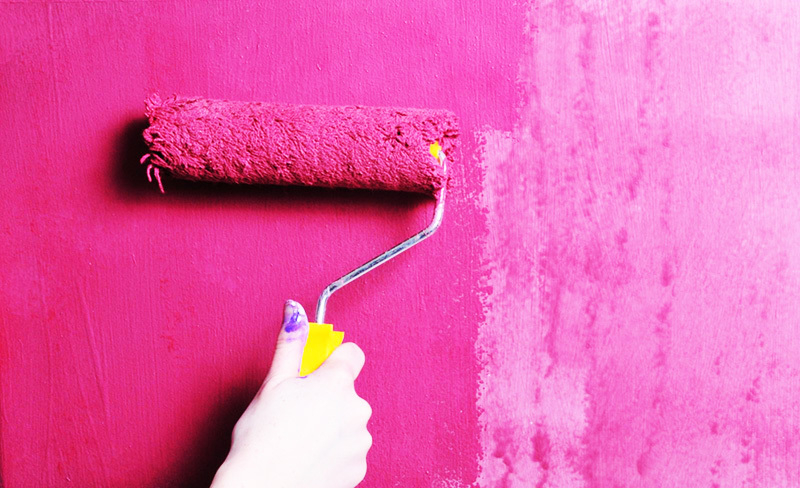
Painting walls and ceilings with acrylic paint
If you decide to paint the walls with acrylic paint with your own hands, you should familiarize yourself with the sequence of work. This will allow you to avoid common mistakes that inexperienced craftsmen make.
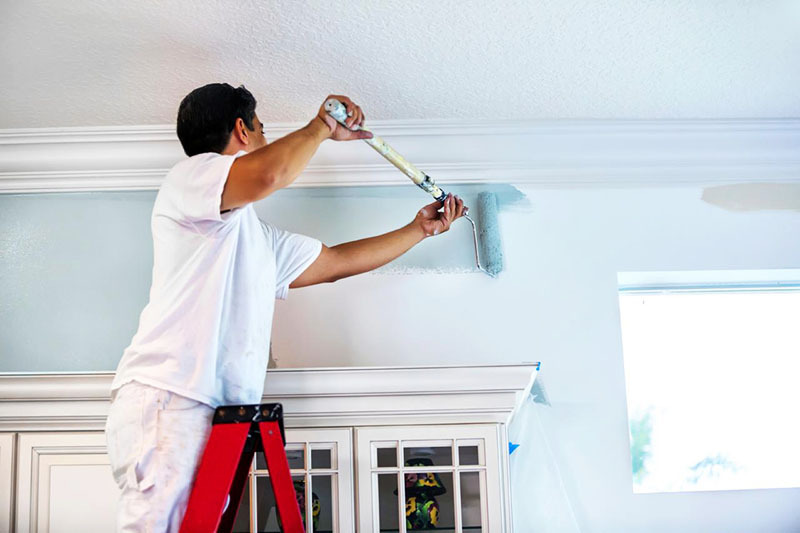
How to prepare the base for painting: sequence of actions
Painting the ceiling with acrylic paint begins with a thorough preparation of the base. The durability of the coating and its performance depend on this. The work is carried out in the following sequence:
- the old coating is removed. A spatula is used to clean the surface;
- all defects are primed;
- the base is putty. To prevent cracking of the putty layer, a mesh is laid under the formed layer;
- the base is leveled with fine-grain sandpaper;
- dust and dirt remaining on the surface is removed.
Attention! If the old paint is firmly attached to the substrate, it can be left and painted over. You should refuse to partially remove the layer, since the base will be uneven.
If you are going to finish the ceiling tiles, you must first seal the joints between the panels with plaster putty. In the presence of strong curvatures, the base should also be leveled with a putty.
Often the question arises whether it is possible to apply acrylic paint on a water-based paint. In this case, it is advisable to completely remove the old coating, since the new layer may not fit well on it.
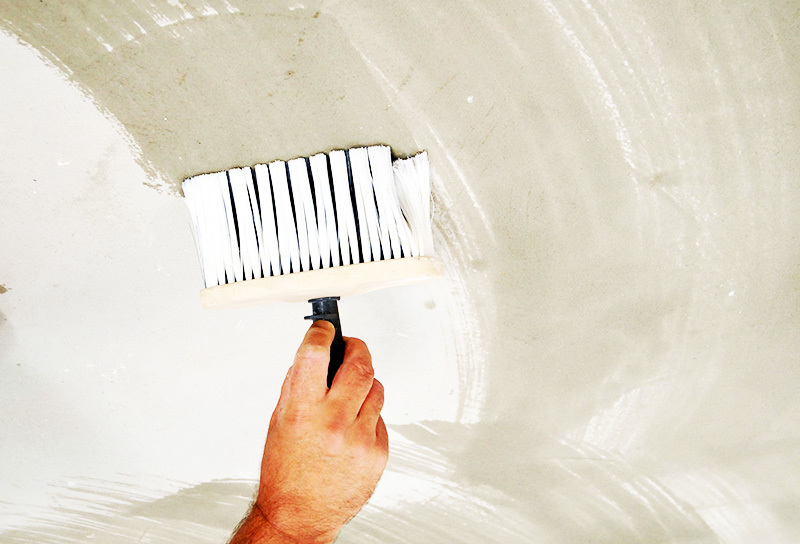
How to paint walls and ceilings with acrylic paint: basic steps
To begin with, it is worth figuring out how to paint the walls with acrylic paint. For work you will need:
- roller;
- brushes;
- masking tape;
- dye tray.

A comment
Mikhail Starostin
Head of the team of the repair and construction company "Dom Premium"
"If you are painting a large area, you should use a spray gun."
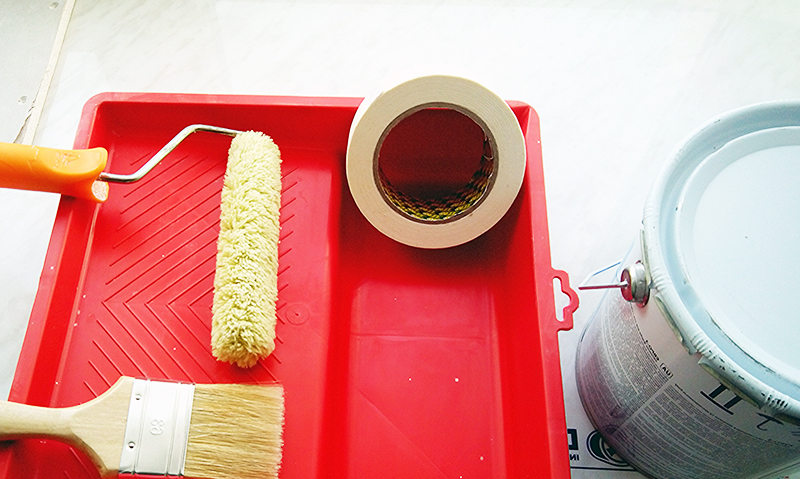
The works are performed in the following sequence:
- all skirting boards, door frames, slopes and other elements, which can get drops of dye, are sealed with oil tape. The composition is thoroughly mixed;
- a small amount of the composition is poured into a tray. With the help of a brush, “inconvenient” places are painted that are difficult to paint with another tool. These are areas adjacent to sockets, pipes, joints, corners;
- a roller is dipped into the dye. The excess is removed. The composition is applied to the wall, moving vertically from above or from the middle. It is possible to perform w-shaped movements;
- After the first layer has dried, the second is applied in the same way.
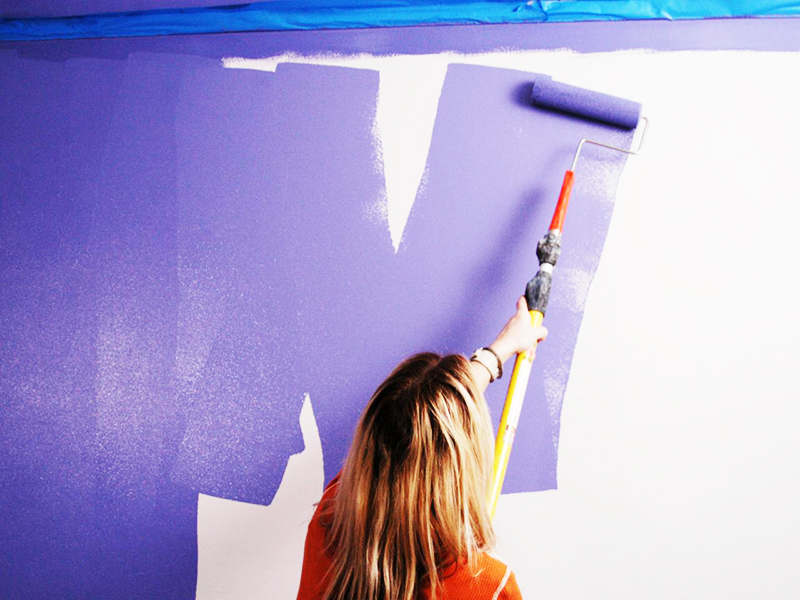
We offer you to watch the video in order to better understand the technology of work performance:
If we talk about how to properly paint the ceiling with acrylic paint, then experts advise:
- start painting from the corner of the ceiling and perform around the perimeter. Thanks to this, it will be possible to quickly paint the central part;
- choose the direction for applying a decorative layer towards the window or any other layer. This will hide the defects on the surface;
- apply the next layer only after the previous one is completely dry.
Advice! Cover the floor with paper before starting work.
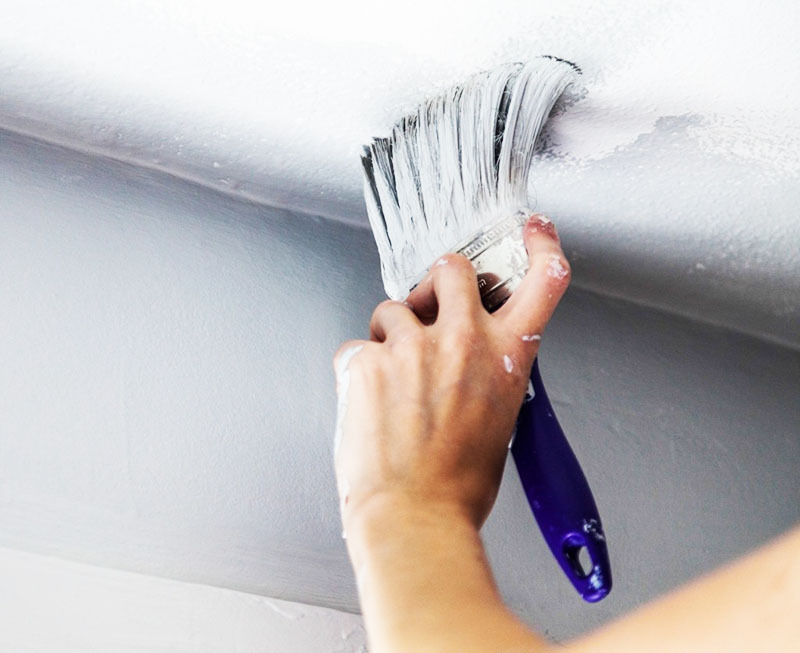
How to dilute acrylic paint for walls and ceilings: possible options
It is worth thinking about how to dilute acrylic paint for walls when you need:
- give the paint the desired shade. To do this, a certain amount of color is added to the composition in order to achieve the required color intensity. The colorants are sold in small containers of 100 ml. By adding this amount to a three liter jar, an intense color can be achieved. The same amount for 7 liters will allow you to get a delicate shade;
- ensure the optimal consistency of the thickened composition. Those who do not know what acrylic paint is diluted with will be pleasantly surprised to learn that ordinary water is needed for this purpose.

A comment
Mikhail Starostin
Head of the team of the repair and construction company "Dom Premium"
"If acrylic paint has been on for a long time and has thickened, run it through a sieve to remove any lumps and particles."
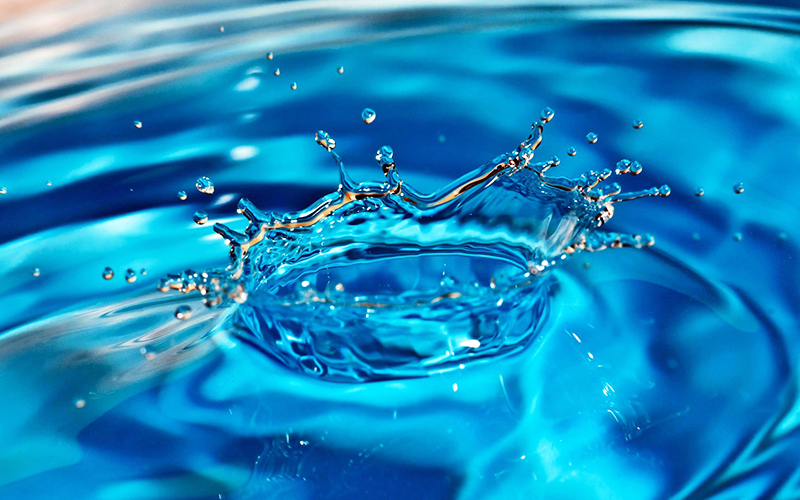
Painting walls with acrylic paints with photos in the interior
After the wall is completely painted, it can be beautifully decorated. Painting the walls with acrylic will add brightness and personality to any room. For this purpose, thick formulations are used. For dilution, special substances can be used.
Attention! You cannot add water to acrylic intended for painting.
We offer you to look at the photos and get acquainted with examples of wall painting with acrylic paints:
1 out of 6
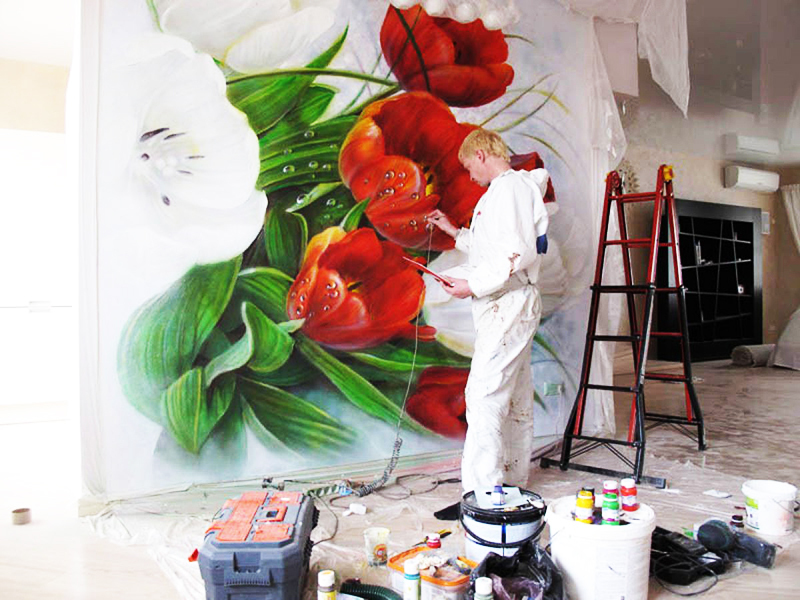
PHOTO: stroyfora.ru
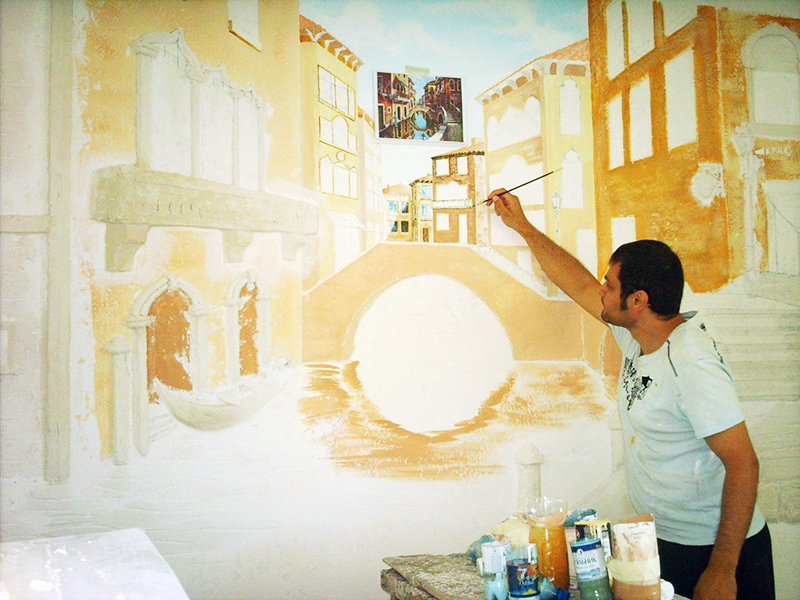
PHOTO: ukrsmeta.ua

PHOTO: twolove.ru

PHOTO: remontnik.ru

PHOTO: remontnik.ru
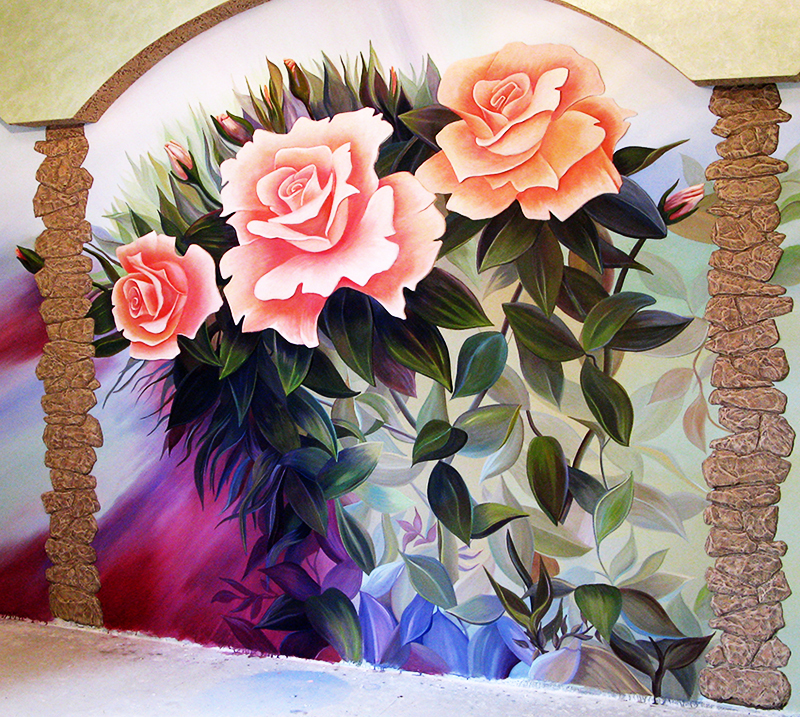
PHOTO: static.wixstatic.com
Leading manufacturers of acrylic paints for interior use
In order for the formed coating to last as long as possible, it is worth giving preference to paints produced by leading manufacturers. Products deserve attention:
- Sniezka super matt. The deeply matte composition produced by this manufacturer is easy to apply, allowing you to qualitatively mask the flaws on the surface;
- Joker. The Finnish company offers formulations that are incapable of harming people with allergies or bronchial asthma. Can be used to decorate a children's room;
- "Tex". Russian products are attracted by their availability. It resists well the negative effects of external factors. State-of-the-art equipment ensures compliance with industry standards;
- Dulux. The products of the Dutch manufacturer occupy a leading position in the market. Possesses high performance characteristics;
- Decolor. Allows you to form a dense layer that is not afraid of mechanical stress;
- Farbitex. The compositions offered by this manufacturer have high adhesion. They work well on a variety of substrates. The ability to form a high-quality coating in one layer allows you to reduce the cost of finishing;
- Interior. High quality acrylic interior paint that can be applied to various substrates;
- Sadolin. The manufacturer's catalog contains compositions that can create an imitation of marble, silk, sand;
- TehnoLux. Quality products of this brand are sold at an affordable cost.
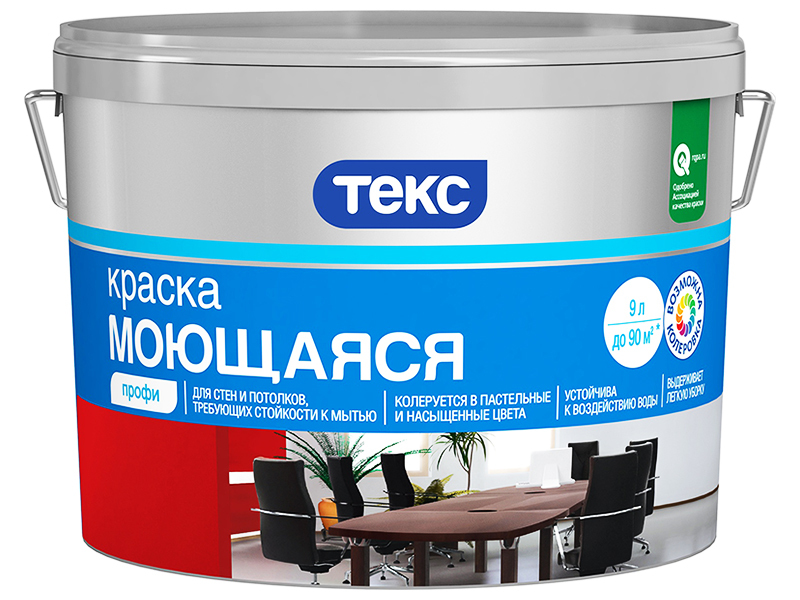
Products from leading manufacturers deserve special attention How much do acrylic paints for walls and ceilings cost - price overview
The cost of the composition depends on its characteristics. The price of a specific container of acrylic paint for walls directly depends on its volume. For 12 liters of a composition intended for painting walls in a dry room, you can pay from 700 rubles. At the same time, a 10-liter jar with moisture-resistant paint will cost at least 1,700 rubles.
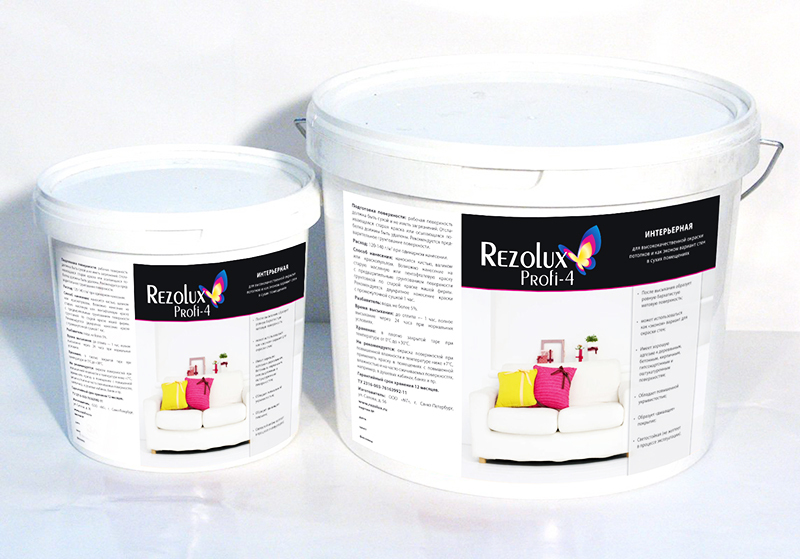
The larger the capacity, the higher the price Share in the comments, have you ever used acrylic paint to paint walls and ceilings? How satisfied are you with the result?
Discuss0



